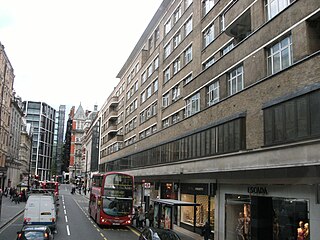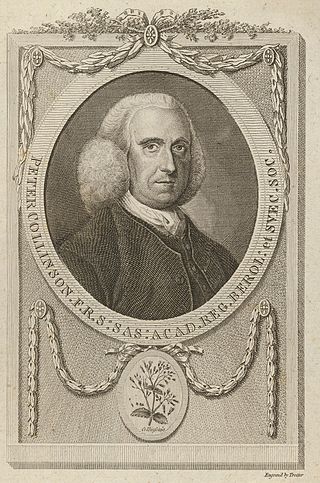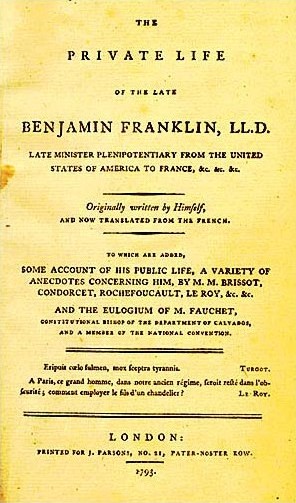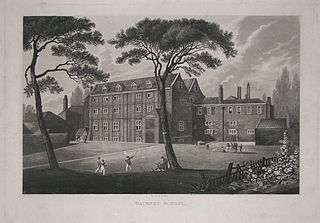
Benjamin Franklin was an American polymath who was active as a writer, scientist, inventor, statesman, diplomat, printer, publisher, and political philosopher. Among the leading intellectuals of his time, Franklin was one of the Founding Fathers of the United States, a drafter and signer of the Declaration of Independence, and the first Postmaster General.

Sir Hans Sloane, 1st Baronet, was an Irish physician, naturalist, and collector, with a collection of 71,000 items which he bequeathed to the British nation, thus providing the foundation of the British Museum, the British Library, and the Natural History Museum, London. He was elected to the Royal Society at the age of 24. Sloane travelled to the Caribbean in 1687 and documented his travels and findings with extensive publications years later. Sloane was a renowned medical doctor among the aristocracy, and was elected to the Royal College of Physicians at age 27. Though he is credited with the invention of chocolate milk, it is more likely that he learned the practice of adding milk to drinking chocolate while living and working in Jamaica. Streets and places were later named after him, including Hans Place, Hans Crescent, and Sloane Square in and around Chelsea, London – the area of his final residence – and also Sir Hans Sloane Square in his birthplace in Northern Ireland, Killyleagh.

William Franklin was an American-born attorney, soldier, politician, and colonial administrator. He was the acknowledged extra-marital son of Benjamin Franklin. William Franklin was the last colonial Governor of New Jersey (1763–1776), and a steadfast Loyalist throughout the American Revolutionary War.

Cheyne Walk is a historic road in Chelsea, London, England, in the Royal Borough of Kensington and Chelsea. It runs parallel with the River Thames. Before the construction of Chelsea Embankment reduced the width of the Thames here, it fronted the river along its whole length.

King's Road or Kings Road, is a major street stretching through Chelsea and Fulham, both in west London. It is associated with 1960s style and with fashion figures such as Mary Quant and Vivienne Westwood. Sir Oswald Mosley's Blackshirt movement had a barracks on the street in the 1930s.

Earl Cadogan is a title that has been created twice in the Peerage of Great Britain for the Cadogan family. The second creation, in 1800, was for Charles Cadogan, 3rd Baron Cadogan.

Cabinets of curiosities, also known as cabinets of wonder and wonder-rooms, were collections of notable objects. Although more rudimentary collections had preceded them, the classic cabinets of curiosities emerged in the sixteenth century. The term cabinet originally described a room rather than a piece of furniture. Modern terminology would categorize the objects included as belonging to natural history, geology, ethnography, archaeology, religious or historical relics, works of art, and antiquities. In addition to the most famous and best documented cabinets of rulers and aristocrats, members of the merchant class and early practitioners of science in Europe formed collections that were precursors to museums.

Sloane Street is a major London street in the Royal Borough of Kensington and Chelsea which runs north to south, from Knightsbridge to Sloane Square, crossing Pont Street about halfway along.

Peter Collinson FRS was an English gardener, botanist and horticulturist. A Fellow of the Royal Society and an avid gardener, Collinson served as the middleman for an international exchange of scientific ideas in Georgian era London.

The Autobiography of Benjamin Franklin is the traditional name for the unfinished record of his own life written by Benjamin Franklin from 1771 to 1790; however, Franklin appears to have called the work his Memoirs. Although it had a tortuous publication history after Franklin's death, this work has become one of the most famous and influential examples of an autobiography ever written.
James Petiver was a London apothecary, a fellow of the Royal Society as well as London's informal Temple Coffee House Botany Club, famous for his specimen collections in which he traded and study of botany and entomology. He corresponded with John Ray and Maria Sibylla Merian. Some of his notes and specimens were used by Carolus Linnaeus in descriptions of new species. The genus Petiveria was named in his honour by Charles Plumier. His collections were bought by Sir Hans Sloane and became a part of the Natural History Museum.
Kenco is a British brand of instant, roast and ground coffee sold by JDE Peet's in the United Kingdom and Ireland. Originally known as the Kenya Coffee Company, they started distributing coffee to Britain in 1923. Shortly after, they opened a coffee shop in Sloane Square and then changed their name to Kenco in 1962.

Hans Place is a garden square in the Knightsbridge district of the Royal Borough of Kensington and Chelsea, London, immediately south of Harrods in SW1. It is named after Sir Hans Sloane, 1st Baronet, PRS, physician and collector, notable for his bequest, which became the foundation of the British Museum.

Cadogan Group Limited and its subsidiaries, including Cadogan Estates Limited, are British property investment and management companies that are owned by the Cadogan family, one of the richest families in the United Kingdom. They also hold the titles of Earl Cadogan and Viscount Chelsea, the latter used as a courtesy title by the Earl's eldest son. The Cadogan Group is the main landlord in the west London districts of Chelsea and Knightsbridge, and it is now the second largest of the surviving aristocratic Freehold Estates in Central London, after the Duke of Westminster's Grosvenor Estate, to which it is adjacent, covering Mayfair and Belgravia.

The Grecian Coffee House was a coffee house, first established in about 1665 at Wapping Old Stairs in London, England, by a Greek former mariner called George Constantine.

Newcome's School was a fashionable boys' school in Hackney, then to the east of London, founded in the early 18th century. A number of prominent Whig families sent their sons there. The school closed in 1815, and the buildings were gutted in 1820. In 1825 the London Orphan Asylum opened on the site. Today the Clapton Girls' Academy is located here.
Mark's Club is a private members' club and restaurant in Mayfair, London, UK. Established in 1972, it has hosted many fashion events and been patronised by members of the British establishment.

Old Slaughter's Coffee House was a coffee house in St Martin's Lane in London. Opened in 1692 by Thomas Slaughter, it was the haunt of many of the important personages of the period. The building was demolished in 1843 when Cranbourn Street was constructed.
Fulke Rose was a British physician and early colonist of Jamaica. He was one of the principal buyers in Jamaica of slaves taken by the Royal African Company and had extensive land-holdings on the island. He continued to practice medicine in Jamaica and with Hans Sloane attended the former privateer Henry Morgan towards the end of Morgan's life.

Button's Coffee House was an 18th-century coffeehouse in London, England. It was situated in Russell Street, Covent Garden, between the City and Westminster.
















